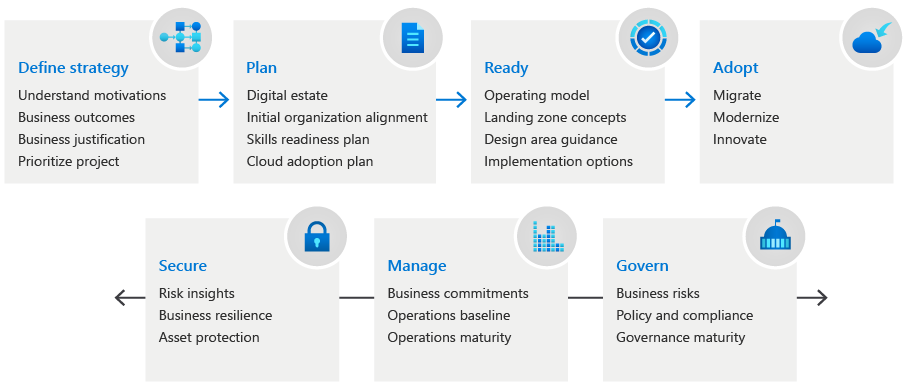Evaluate migration with the Cloud Adoption Framework
The Microsoft Cloud Adoption Framework for Azure provides recommendations, best practice guidance, documentation, and tools to help you drive adoption of Azure in your organization. The Cloud Adoption Framework supports methodologies for defining your strategy, planning and preparing for your migration, and establishing organizational structure to align your teams and roles. You can migrate and modernize existing workloads and develop new cloud-native or hybrid solutions. You can employ Cloud Adoption Framework tools to govern your environment and workloads and manage operations for cloud and hybrid solutions.
This diagram illustrates Cloud Adoption Framework methodologies within a cloud adoption lifecycle.

Things to know about cloud adoption and migration
Tailwind Traders shouldn't undertake cloud adoption without considerable planning. Proceeding with caution is especially recommended for the migrate phase in the cloud adoption lifecycle. To prepare for migration, review the following documentation:
Azure migration guide overview. Review the Azure migration guide to learn about Azure native tools and a relevant approach to migration.
The One Migrate approach to migrating the IT portfolio. Examine the scenarios captured in the migrate methodology. The examples demonstrate the same set of consistent guidelines and processes for migrating both Microsoft and third-party technologies.
The Cloud Adoption Framework migration model. Explore this document to understand migration and why the process can be an intensive activity. As you increase your migration effort, review these process improvements to help optimize aspects of your migration.
Things to consider when implementing migration adoption
The migration adoption process for Tailwind Traders should consist of three phases or efforts for each workload: Assess, Deploy, and Release. The following table and illustration summarize the migration adoption efforts.
| Effort | Description |
|---|---|
| Assess | Assess your workloads to determine costs, modernization, and required deployment tools. |
| Deploy | After you assess your workloads, the existing workload functionality is replicated (or improved) in the cloud. |
| Release | After your workloads are deployed (replicated) to the cloud, you can test, optimize, and document your migrated workloads. When you're ready, you can release the workloads to your users. During the Release effort, be sure to hand off the workloads to governance, operations management, and security teams for ongoing support of the workloads. |
